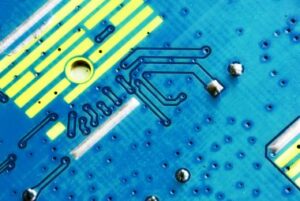How to Avoid Solder Balls to Get Perfect SMT Manufacturing
2022-09-28With the gradual development of electronic products toward lighter, thinner and smaller continuously. It has prompted more and more electronic products for different applications to adopt surface mount (SMT) technology.
In the SMT manufacturing process, the generation of solder beads has a great impact on electronic products, which can be caused by a variety of reasons and can eventually lead to PCBs failure. What exactly is a solder ball? This article will explain the causes of solder ball formation and how to avoid it.
What is a solder ball?
A solder ball is literally understood as a metal alloy ball formed on the surface of the PCB after welding. Solder ball mainly appears on the side of the SMD components or between the IC pins, if in the formation if not timely processing. It will not only affect the appearance of the product, but serious may also lead to short circuits in the process of use, and even harm the human body.
Some of the reasons for the formation of solder balls are
- High humidity
- Excessive flux in the solder paste
- Reflow process of high temperature or high pressure
- Improper cleaning
Best practices to prevent solder balls from forming
Ensure proper humidity
Too much moisture in the PCB will cause the generation of solder beads when the moisture expands dramatically to produce gas when it passes through the reflow oven after posting. Therefore, it is required that PCBs must be vacuum packed between putting into SMT production, and if there is moisture needs to be baked in an oven before use.
Select the right solder paste
The metal content of the solder paste, oxide content, metal powder particle size, solder paste activity, etc. all affects the formation of tin beads to varying degrees.
Preheat PCB
The higher the preheat temperature, the preheat zone is too rapid, it will increase the splash of gasification phenomenon, and the easier to form tin beads. Therefore, adjust the reflow oven temperature, reduce the conveyor belt speed, and take a more moderate preheating temperature and preheating speed to control the beads.
Solder resist
Ensure that the solder resists the layer in place and the correct use of solder paste so that there is no gap between the alignment and the pad. Use high-quality equipment while maintaining the board's preheating speed.
Pad Spacing
Incorrectly placed pads not only lead to solder ball formation, but also to solder ball dislodgement and short circuits. Therefore, pads must be placed in an optimal manner.
Stencil
Stencil openings without anti-tin bead treatment, improper opening, too large, offset, or too thick can lead to tin bead generation. And clean stencil is also very important, clean stencil is not timely, or wipe incomplete, resulting in residual solder paste on the back of the stencil, and contamination of the PCB board surface, resulting in tin beads.
To sum up
In SMT production, there are many reasons for tin beads, only focus on one aspect or adjust a parameter is far from enough. It is necessary to control every detail at each stage of PCB production so that the soldering can achieve the best results and meet the high-quality requirements of electronic manufacturing technology.
It is important to choose the right electronic contract manufacturer, KingPCB has extensive manufacturing experience and strict quality control measures to provide high quality PCBs. we have more than 10 years of experience in SMT assembly, if you are looking for high quality SMT PCB solutions, you can contact us or via email to send your inquiry!
Prev: Guidelines for Reducing PCB Costs
Next: Copper-Filled Vias




